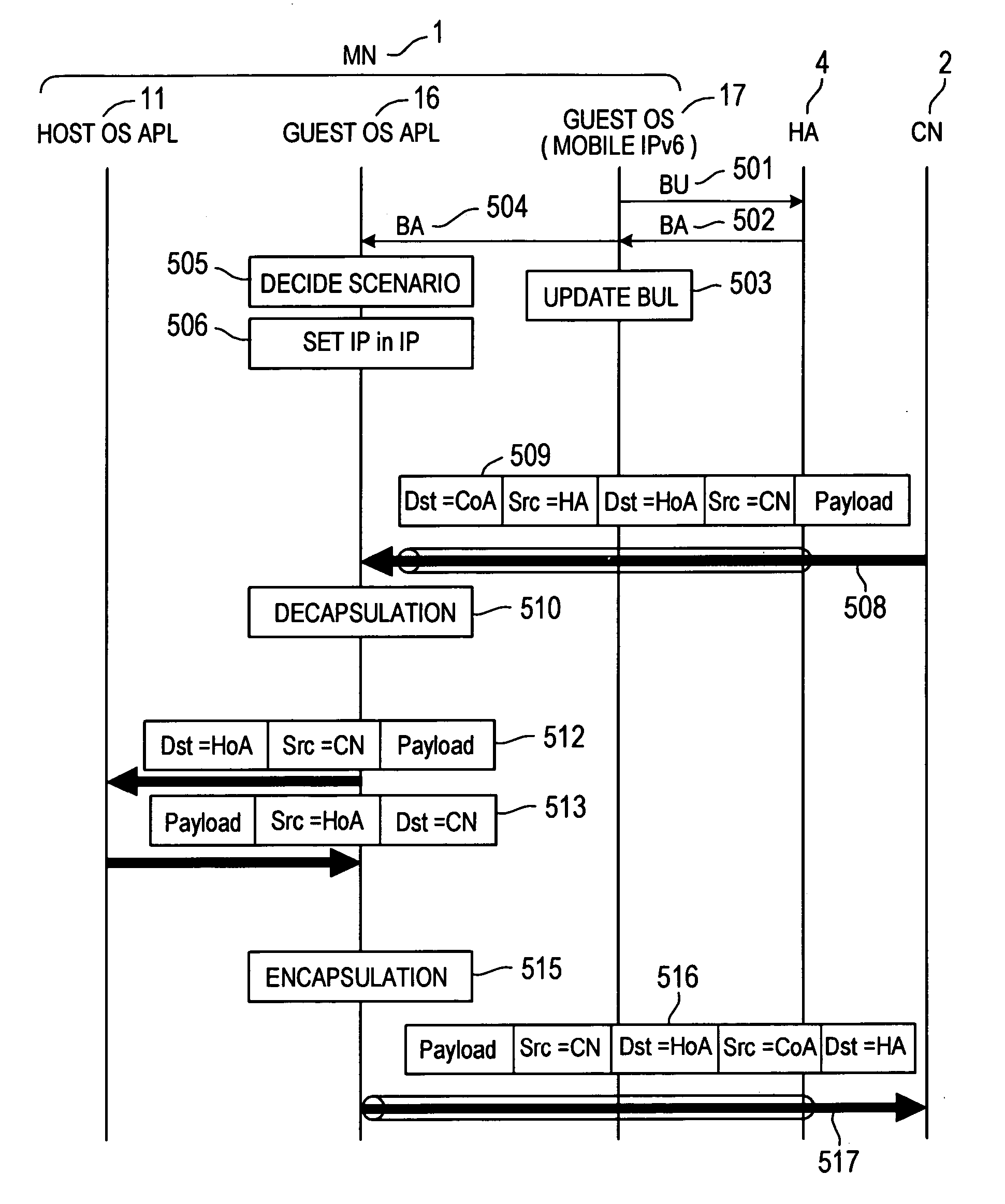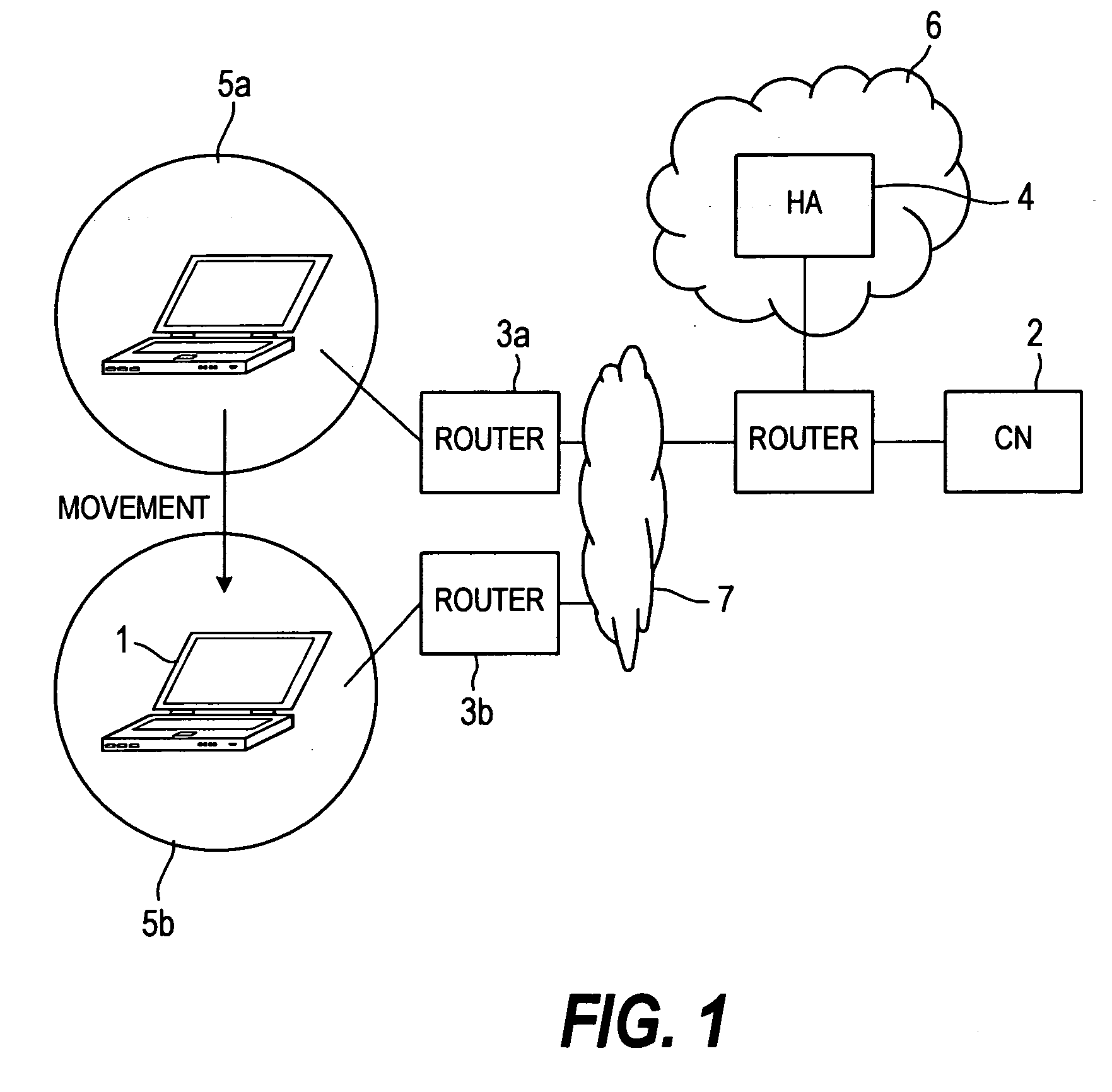Terminal and communication system
a communication system and terminal technology, applied in the field of terminals, can solve the problems of few mobile nodes conforming to the mobile ipv6 specifications, and achieve the effect of more complicated processing
- Summary
- Abstract
- Description
- Claims
- Application Information
AI Technical Summary
Benefits of technology
Problems solved by technology
Method used
Image
Examples
first embodiment
[0086] A first embodiment of the present invention is explained by referring to diagrams.
[0087] As a typical representative, the following description explains details of a communication method, which is adopted when an MN (mobile node) conforming to the Mobile IPv6 specifications moves to a network outside a home link, which is also referred to hereafter as a home network. In the following description, the network outside the home link is referred to as a visited network.
[0088]FIG. 1 is a diagram showing a typical configuration of a communication network according to the present invention. The communication network provided by the present invention includes a home network 6 of an MN (mobile node) 1, an IP network 7 as well as visited networks 5 (i.e., visited networks 5a and 5b). In this embodiment, the home network 6, the IP network 7 and the visited networks 5 are each an IPv6 network. The MN 1 is a mobile node conforming to the Mobile IPv6 specifications. The visited networks ...
second embodiment
[0121] Next, a second embodiment of the present invention is explained by referring to diagrams. The second embodiment is characterized in that the second embodiment includes a means for rendering a Mobile IPv6 service to a terminal, which includes an application conforming to IPv6 specifications, in addition to the means employed in the first embodiment.
[0122] Assume that, in the scenario policy management table 220, the entry ‘No IPv4-IPv6 translation function and no IPsec’ is effective. In this case, the IPv6-packet processing part 24 processes all packets received by the MN 1.
[0123] According to a sequence shown in FIG. 12, the MN 1 existing in the visited network 5b shown in FIG. 1 registers its location in the HA 4 before exchanging a packet. The sequence shown in FIG. 12 is explained as follows.
[0124] Processes carried out in steps 501 to 504 as processes starting with a process performed by the MN 1 to acquire a CoA in the visited network and ending with a process perform...
third embodiment
[0131] A third embodiment of the present invention is explained by referring to diagrams.
[0132] The third embodiment is characterized in that the third embodiment includes a means for rendering a Mobile IPv6 service to a terminal, which applies IPsec to a mobile IP signal, in addition to the means employed in the first embodiment.
[0133] IPsec is security functions used in IETF to perform standardization. To be more specific, IPsec has functions to authenticate and encrypt a packet. An IP packet to which the authentication function of IPsec has been applied has an AH (Authentication Header). On the other hand, an IP packet to which the encryption function of IPsec has been applied has an ESP (Encapsulating Security Payload) header.
[0134] According to a sequence shown in FIGS. 19 to 22, the MN 1 existing in the visited network 5b shown in FIG. 1 registers its location in the HA 4 before exchanging a packet. The sequence shown in FIGS. 19 to 22 is explained as follows.
[0135] Assume...
PUM
 Login to View More
Login to View More Abstract
Description
Claims
Application Information
 Login to View More
Login to View More - R&D
- Intellectual Property
- Life Sciences
- Materials
- Tech Scout
- Unparalleled Data Quality
- Higher Quality Content
- 60% Fewer Hallucinations
Browse by: Latest US Patents, China's latest patents, Technical Efficacy Thesaurus, Application Domain, Technology Topic, Popular Technical Reports.
© 2025 PatSnap. All rights reserved.Legal|Privacy policy|Modern Slavery Act Transparency Statement|Sitemap|About US| Contact US: help@patsnap.com



